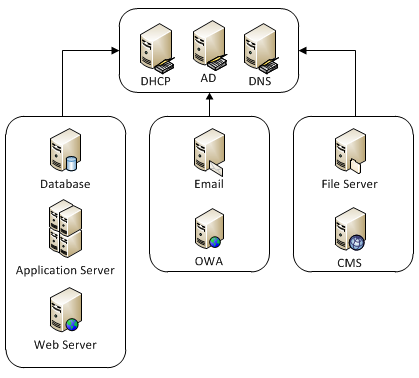Dependencies can be service-to-service; for example, a web application depends on a frontend web server and a backend database. Dependencies can be service-to-infrastructure; for example, a web application requires a static IP address and a minimum of 10 MB of network bandwidth.
Physical and infrastructure dependencies are generally easier to discover and are commonly documented. Applications will have dependencies, which include server resources, network resources, and storage resources. Infrastructure dependencies that are not documented are often readily discovered as part of the current state assessment. The following table is an example of how physical application dependencies can be documented:
|
Application |
OS |
CPU cores |
Speed (GHz) |
RAM (GB) |
Network (GBps) |
Network (VLAN) |
Storage |
|
IIS |
Win2k8 R2 |
4 |
2.7 |
16 |
1 |
22 |
50 GB |
|
SQL database |
Win2k8 R2 |
8 |
2.7 |
32 |
1 |
22 |
1 TB |
Service-to-service or application-to-service dependencies can be a bit more difficult to discover. Application owners, application developers, application documentation, and application vendors will be the best sources for determining these dependencies. As with Capacity Planner, if you work for VMware or a VMware partner, you're entitled to use VMware Application Dependency Planner (ADP).
The following diagram is an example of how service dependencies can be mapped and documented:

Understanding the dependencies will help an architect to understand how a change made to one area of the design may have an effect on another area of the design. Mapping and documenting application dependencies will provide the necessary information to properly design a solution for business continuity and disaster recovery. Understanding the dependencies will also aid in troubleshooting issues with the design implementation.
Beware, there may be undocumented dependencies that are not easily discovered. This can often be a risk to the design, especially in an organization with a legacy of unsupported applications or applications developed in-house that have not been properly documented.
I have seen issues where a specific configuration, such as an IP address or a file location, has been hardcoded into an application and not documented. A change is made to the environment and hence the application becomes unavailable. Dependencies of this type can be extremely difficult to plan for and discover.
There are tools available that can help you to discover application dependencies automatically. If you work for VMware or a VMware partner, you have free access to the VMware Application Dependency Planner (ADP) software. ADP ships as a pre-built OVF virtual appliance and comes with several components. There's a database to store all the dependency information, collector VMs to receive Ethernet traffic, and an Aggregator VM which acts as a manager and central configuration point of the application. The idea of ADP is to sniff Ethernet traffic to understand the communication paths between servers in an environment. ADP then builds a visual map that helps consultants to easily understand application dependencies. The map includes IP addresses, hostnames, port numbers, and protocols which helps to quickly identify which servers are talking with one another.
